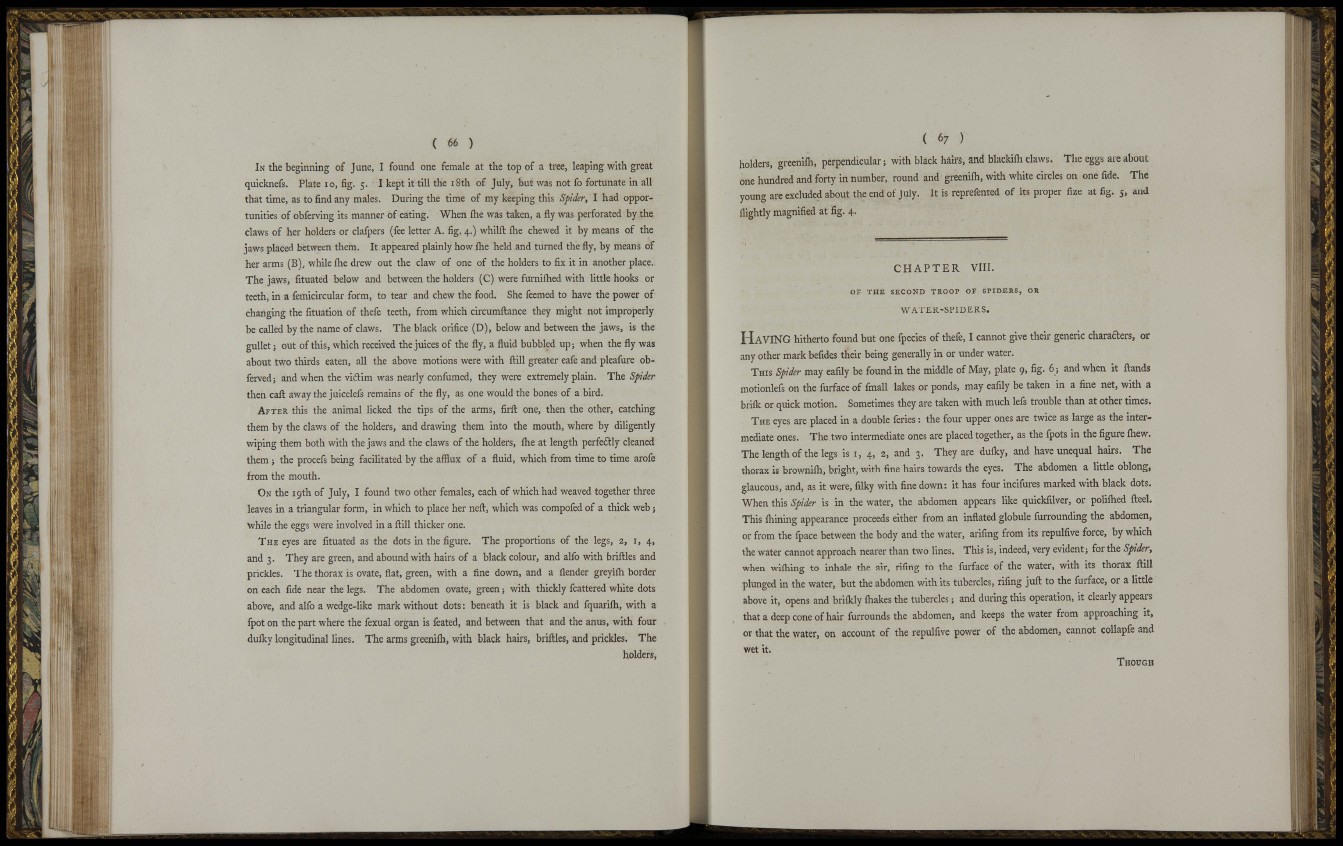
( 66 )
IN the beginning of June, I found one female at the top of a tree, leaping with great
quicknefs. Plate i o, fig. 5. I kept it till the 18th of July, but was not fo fortunate in all
that time, as to find any males. During the time of my keeping this Spider, I had opportunities
of obferving its manner of eating. When ihe was taken, a fly was perforated by the
claws of her holders or clafpers (fee letter A. fig. 4.) whilft ihe chewed it by means of the
jaws placed between them. It appeared plainly how ihe held and turned the fly, by means of
her arms (B), while ihe drew out the claw of one of the holders to fix it in another place.
The jaws, fituated below and between the holders (C) were furnifhed with little hooks or
teeth, in a femicircular form, to tear and chew the food. She feemed to have the power of
changing the fituation of thefe teeth, from which circumftance they might not improperly
be called by the name of claws. The black orifice (D), below and between the jaws, is the
gullet; out of this, which received the juices of the fly, a fluid bubbled up; when the fly was
about two thirds eaten, all the above motions were with ftill greater eafe and pleafure obferved;
and when the viftim was nearly confumed, they were extremely plain. The Spider
then cail away the juicelefs remains of the fly, as one would the bones of a bird.
A F T E R this the animal licked the tips of the arms, firft one, then the other, catching
them by the claws of the holders, and drawing them into the mouth, where by diligently
wiping them both witli the jaws and the claws of the holders, ihe at length perfeftly cleaned
them ; the procefs being facilitated by the afflux of a fluid, which from time to time arofe
from the mouth.
ON the 19th of July, I found two other females, each of which had weaved together three
leaves in a triangular form, in which to place her neit, which was compofed of a thick web ;
while the eggs were involved in a ftill thicker one.
THE eyes are fituated as the dots in the figure. The proportions of the legs, 2, i, 4,
and 3. They are green, and abound with hairs of a black colour, and alfo with briftles and
prickles. The thorax is ovate, flat, green, with a fine down, and a flender greyifli border
on each fide near the legs. The abdomen ovate, green ; with thickly fcattered white dots
above, and alfo a wedge-like mark without dots : beneath it is black and fquarifh, with a
fpot on the part where the fexual organ is feated, and between that and the anus, with four
duiky longitudinal hnes. The arms greeniih, with black hairs, briftles, and prickles. The
holders.
( 67 )
holders, greeniih, perpendicular; with black hairs, and blackiih claws. The eggs are about
one hundred and forty in number, round and greeniih, with white circles on one fide. The
young are excluded about the end of July. It is reprefented of its proper fize at fig. 5, and
flightly magnified at fig. 4.
C H A P T E R VIII.
OF THE SECOND TROOP OF SPIDERS, OR
W A T E K - S P I D E R S .
H A V I N G hitherto found but one fpecies of thefe, I cannot give their generic charafters, or
any other mark befides their being generally in or under water.
T H I S Spider may eafily be found in the middle of May, plate 9, fig. 6; and when it fl:ands
motionlefs on the furface of fmall lakes or ponds, may eafily be taken in a fine net, with a
brifk or quick motion. Sometimes they are taken with much lefs trouble than at other times.
THE eyes are placed in a double feries : the four upper ones are twice as large as the intermediate
ones. The two intermediate ones are placed together, as the fpots in the figure ihew.
The length of the legs is r, 4, 2, and 3. They are duiky, and have unequal hairs. The
thorax is brownifti, bright, with fine hairs towards the eyes. The abdomen a little oblong,
glaucous, and, as it were, filky with fine down: it has four incifures marked with black dots.
When this Spider is in the water, the abdomen appears like quickfilver, or polifhed ileel.
This fhining appearance proceeds either from an inflated globule furrounding the abdomen,
or from the fpace between the body and the water, arifing from its repulfive force, by which
the water cannot approach nearer than two lines. This is, indeed, very evident; for the Spider,
when wiihing to inhale the air, rifmg to the furface of the water, with its thorax flill
plunged in the water, but the abdomen with its tubercles, rifing juft to the furface, or a little
above it, opens and briikly ftiakes the tubercles; and during this operation, it clearly appears
that a deep cone of hair furrounds the abdomen, and keeps the water from approaching it,
or that the water, on account of the repulfive power of the abdomen, cannot collapfe and
wet it.
THOUGH
i-üi'
m